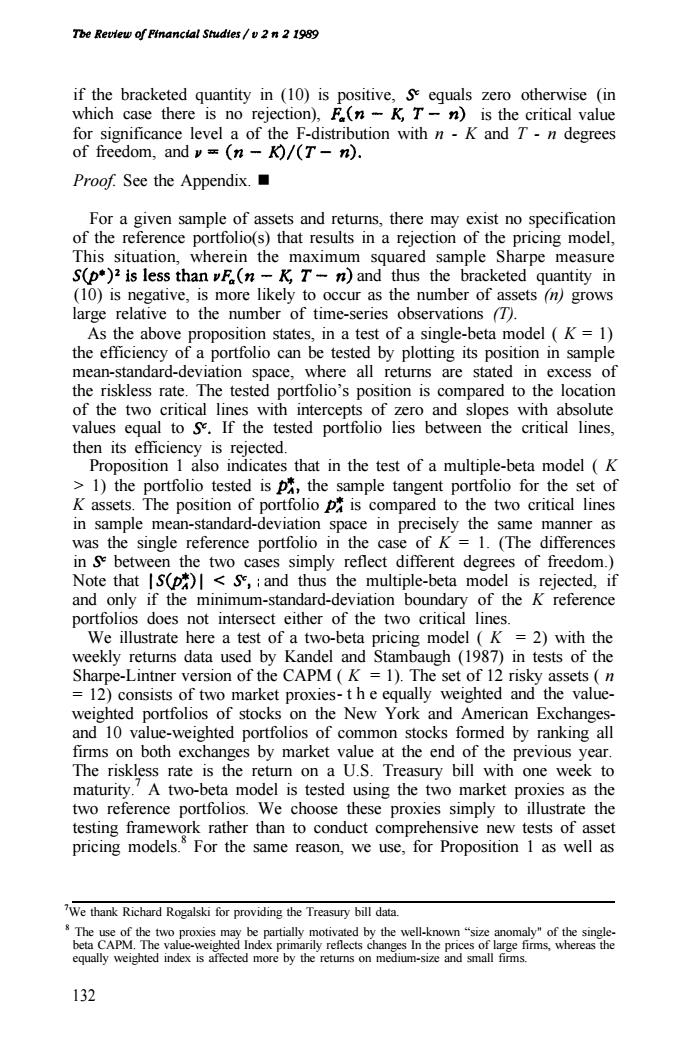正在加载图片...

Tbe Review of Financtal Studtes/v 2 n 2 1989 if the bracketed quantity in (10)is positive,s equals zero otherwise (in which case there is no rejection),F(n-K,T-n)is the critical value for significance level a of the F-distribution with n-K and T-n degrees of freedom,and y=(n-K)(T-n). Proof.See the Appendix. For a given sample of assets and returns,there may exist no specification of the reference portfolio(s)that results in a rejection of the pricing model, This situation,wherein the maximum squared sample Sharpe measure s(p*)2 is less than vF(n-K,T-n)and thus the bracketed quantity in (10)is negative,is more likely to occur as the number of assets (n)grows large relative to the number of time-series observations (T). As the above proposition states,in a test of a single-beta model (K=1) the efficiency of a portfolio can be tested by plotting its position in sample mean-standard-deviation space,where all returns are stated in excess of the riskless rate.The tested portfolio's position is compared to the location of the two critical lines with intercepts of zero and slopes with absolute values equal to s.If the tested portfolio lies between the critical lines, then its efficiency is rejected. Proposition 1 also indicates that in the test of a multiple-beta model (K >1)the portfolio tested is p,the sample tangent portfolio for the set of K assets.The position of portfolio p is compared to the two critical lines in sample mean-standard-deviation space in precisely the same manner as was the single reference portfolio in the case of K=1.(The differences in S between the two cases simply reflect different degrees of freedom.) Note that Is(p)<s,and thus the multiple-beta model is rejected,if and only if the minimum-standard-deviation boundary of the K reference portfolios does not intersect either of the two critical lines. We illustrate here a test of a two-beta pricing model (K =2)with the weekly returns data used by Kandel and Stambaugh (1987)in tests of the Sharpe-Lintner version of the CAPM(K =1).The set of 12 risky assets (n =12)consists of two market proxies-t h e equally weighted and the value- weighted portfolios of stocks on the New York and American Exchanges- and 10 value-weighted portfolios of common stocks formed by ranking all firms on both exchanges by market value at the end of the previous year. The riskless rate is the return on a U.S.Treasury bill with one week to maturity.'A two-beta model is tested using the two market proxies as the two reference portfolios.We choose these proxies simply to illustrate the testing framework rather than to conduct comprehensive new tests of asset pricing models."For the same reason,we use,for Proposition 1 as well as We thank Richard Rogalski for providing the Treasury bill data. 8 The use of the two proxies may be partially motivated by the well-known"size anomaly"of the single- beta CAPM.The value-weighted Index primarily reflects changes In the prices of large firms,whereas the equally weighted index is affected more by the returns on medium-size and small firms. 132if the bracketed quantity in (10) is positive, equals zero otherwise (in which case there is no rejection), is the critical value for significance level a of the F-distribution with n - K and T - n degrees of freedom, and Proof. See the Appendix. n For a given sample of assets and returns, there may exist no specification of the reference portfolio(s) that results in a rejection of the pricing model, This situation, wherein the maximum squared sample Sharpe measure and thus the bracketed quantity in (10) is negative, is more likely to occur as the number of assets (n) grows large relative to the number of time-series observations (T). As the above proposition states, in a test of a single-beta model ( K = 1) the efficiency of a portfolio can be tested by plotting its position in sample mean-standard-deviation space, where all returns are stated in excess of the riskless rate. The tested portfolio’s position is compared to the location of the two critical lines with intercepts of zero and slopes with absolute values equal to If the tested portfolio lies between the critical lines, then its efficiency is rejected. Proposition 1 also indicates that in the test of a multiple-beta model ( K > 1) the portfolio tested is the sample tangent portfolio for the set of K assets. The position of portfolio is compared to the two critical lines in sample mean-standard-deviation space in precisely the same manner as was the single reference portfolio in the case of K = 1. (The differences in between the two cases simply reflect different degrees of freedom.) Note that and thus the multiple-beta model is rejected, if and only if the minimum-standard-deviation boundary of the K reference portfolios does not intersect either of the two critical lines. We illustrate here a test of a two-beta pricing model ( K = 2) with the weekly returns data used by Kandel and Stambaugh (1987) in tests of the Sharpe-Lintner version of the CAPM ( K = 1). The set of 12 risky assets ( n = 12) consists of two market proxies-the equally weighted and the valueweighted portfolios of stocks on the New York and American Exchangesand 10 value-weighted portfolios of common stocks formed by ranking all firms on both exchanges by market value at the end of the previous year. The riskless rate is the return on a U.S. Treasury bill with one week to maturity.7 A two-beta model is tested using the two market proxies as the two reference portfolios. We choose these proxies simply to illustrate the testing framework rather than to conduct comprehensive new tests of asset pricing models.8 For the same reason, we use, for Proposition 1 as well as 7We thank Richard Rogalski for providing the Treasury bill data. 8 The use of the two proxies may be partially motivated by the well-known “size anomaly" of the singlebeta CAPM. The value-weighted Index primarily reflects changes In the prices of large firms, whereas the equally weighted index is affected more by the returns on medium-size and small firms. 132